With the new Hilbert Museum of California Art, Chapman provides a window to a genre as vivid and evocative as its regional influences.
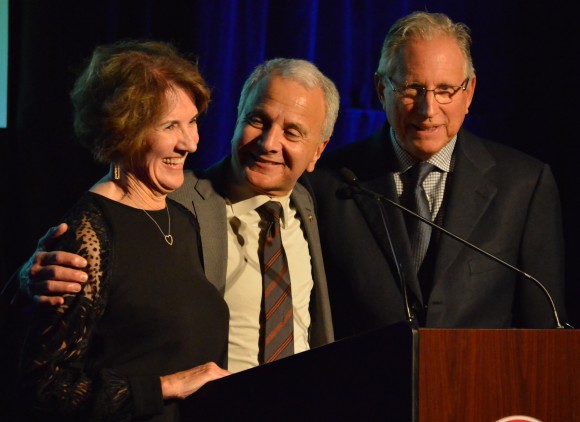
President Jim Doti, center, praises the “personal vision” of Janet and Mark Hilbert during a recent celebration and mini-exhibition of paintings in the Hilbert Collection. At the top of this blog post is “San Dimas Train Station,” a 1933 watercolor that highlights the quality of the collection.
In the gathering darkness of an early evening, two men wait for a train at a small rural station. The human figures, heads bowed, each isolated under a lamp, seem to be wrapped in their own thoughts as they wait to be taken somewhere, anywhere … elsewhere. It’s a timeless scene, except for the telephone poles that stretch diagonally into the background, and the car that sits just out of the center light’s reach. Those elements, and the lonely mood evoked by the artist, set the image firmly in the era of America’s Great Depression. his melancholy, thought-provoking moment in time was captured in watercolor in 1933 by California artist Millard Sheets, one of the leading lights of what came to be called California Scene painting — which was part of the American Regionalist art movement. The evocative image is every inch as powerful as a slightly later Regionalist art icon, Edward Hopper’s 1942 Night Hawks — but much less well known. That will all change soon, if Newport Coast art collectors Mark and Janet Hilbert and Chapman University have anything to say about it.
In November, Chapman announced that it had received a major gift of California art, valued at more than $7 million, from the Hilberts, in addition to $3 million from the couple toward establishing a museum on campus in which to permanently display the collection to the public. The gift was celebrated with a mini-exhibition of a dozen of the paintings — including the aforementioned San Dimas Train Station by Sheets — followed by a dinner party in the 96-year-old former Villa Park Orchards Packing House in Orange. Chapman owns the historic property, which will become the site of the museum.
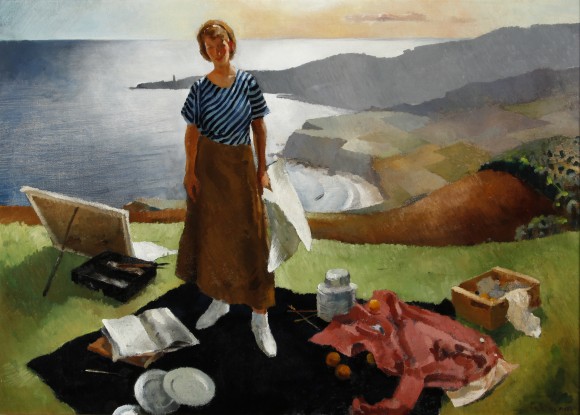
“Mary by the Sea” by Lee Blair depicts the artist’s wife, also a fine artist, picnicking on the Palos Verdes Peninsula. The two had significant careers in Hollywood’s animation studios as well as in fine art. Mary Blair became known as one of Walt Disney’s favorite artists and in 1964 designed the “It’s a Small World” ride at Disneyland.
“This will be the first museum anywhere that is totally dedicated to the display of California Scene and California representational art,” said Mark Hilbert. “The intent will be to cast a spotlight on this style of painting and these amazing artists, and to make this art known around the world. California has its own style, its own light, its own distinct landscape. California Scene paintings are distinguished from the earlier style of California Impressionism because these works show people and the works of humans: towns, cities, harbors, houses, ranches, cars, trains — people going about their everyday lives. These paintings show the changes taking place across our state as it grew, starting around 1920 — changes that are still happening and reflected in today’s representational art.”
LUMINOUS WORKS
A portion of the Hilbert collection of more than 900 paintings — mostly works in watercolor and oil created from the 1930s to the 1970s by luminaries of the California Scene movement such as Sheets, Emil Kosa Jr., Phil Dike, Milford Zornes and Rex Brandt — will be displayed at first in a temporary museum Chapman will create in a renovated University-owned building on Cypress Street in Orange.
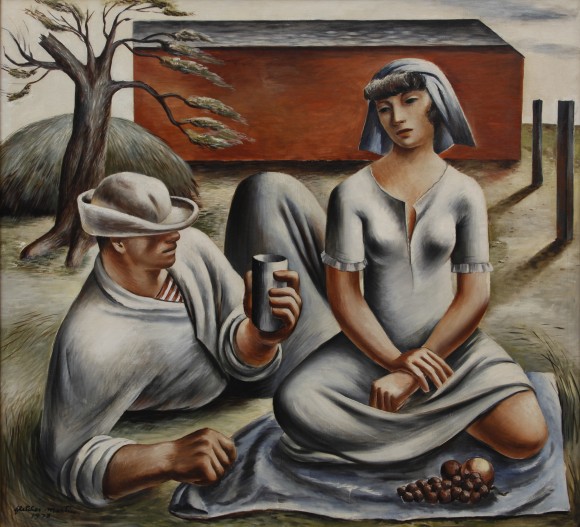
“Bucolic” by Fletcher Martin shows a couple enjoying a picnic in a rural setting, but there is an air of subtle mystery about it. The bold, weighty volume of the figures shows the influence of famed Mexican muralist David Alfaro Siquieros.
Later, a larger segment of the collection, plus rotating exhibitions, will be displayed in the permanent Hilbert Museum of California Art, planned to be constructed inside the former citrus packing house on the corner of Cypress Street and Palm Avenue in Orange. The building is scheduled to open as a multi-use facility, including the museum, dining spaces and academic areas. The Hilberts’ $3 million monetary donation will be used toward the establishment of the museum, to support the collection and to enhance its educational mission.
“This is an incredibly important gift to Chapman University, and we are honored that the world-class Hilbert Collection of California Art has been placed into our care to share with our students, the Chapman community and the public,” said Chapman President Jim Doti. “The art, the lives of the artists, their place in California art and American art history, and the personal vision of the amazing couple who collected the works have much to teach all of us.”
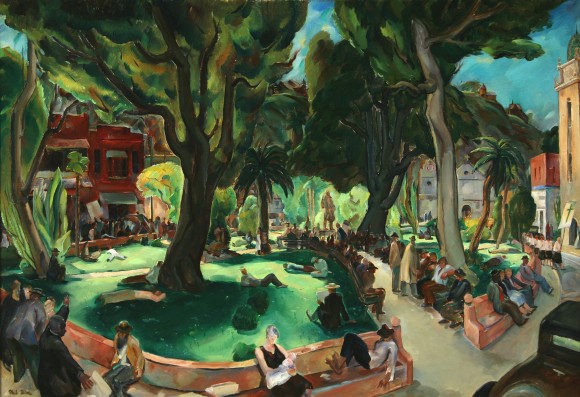
“Plaza de Los Angeles on Sunday” by Phil Dike shows people from all walks of life relaxing on the green and on surrounding benches in this 1942 oil painting. This parklike plaza is the site of the oldest settled area of the city, El Pueblo de la Reina de Los Angeles, near Olvera Street and across from Union Station.
“We’re delighted that Chapman University will be the new home of these works we have devoted ourselves to collecting, and that they will be shared with the students, faculty, visiting researchers and the wider public,” said Mark Hilbert. “We feel that the University’s mission and Chapman’s unique location in historic Old Towne Orange — already a magnet for those interested in the rich California history of the area — make it the perfect location for a museum showcasing these works, inspiring people with their beauty and encouraging intellectual inquiry.”
SETTING THE SCENE
California Scene painters were highly creative and imaginative in their individual approaches but always produced works based on subject matter that is easy to recognize. Their inspiration ranges from city to country scenes, from the coastline to figurative and still-life subjects. From 1930 to 1970, these artists were key contributors to what became known as the California Style of watercolor painting. The innovative works they produced received national and international acclaim, as did the animated cartoon films that many of the artists worked on at Walt Disney and other studios. The fine-art watercolors and animation production art will be featured in special exhibits at the Hilbert Museum of California Art.
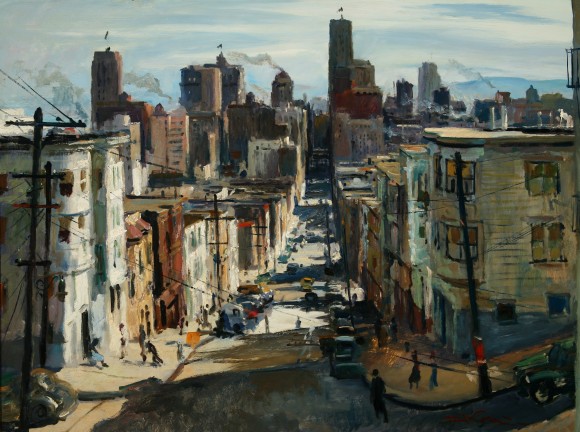
“San Francisco” by Emil Kosa Jr. is done in dark colors that may reflect the emotions of the artist as World War II raged in 1942. The work was painted on location.
When the artists focused on scenes of everyday life in California, and the art reveals signs of humanity by including people or manmade objects — such as cars, buildings, freeways, piers or factories — the works are often referred to as California Scene paintings. Many of the works in the Hilbert Collection fall into this category, making them the center of attention for the permanent museum collection exhibit. Mark Hilbert says the museum will focus on California Scene works but will also display California representational art of all eras, including contemporary works from recent years.
“It’s the power of imagery,” Hilbert says. “The way we’re wired as human beings is that we will remember an image long after we forget a lot of written information, and we often connect that image with a time and place. Take the Mona Lisa — there’s hardly anyone in the world who doesn’t know that Leonardo da Vinci’s masterpiece is in the Louvre in France. Or that the Sistine Chapel is in Rome. They’re part of the culture and the history there, just as this museum of California art belongs in Orange County, at Chapman University, in a historic building right in the heart of Old Towne. It’s where history, culture and imagery coincide, and it makes perfect sense to have it here.”
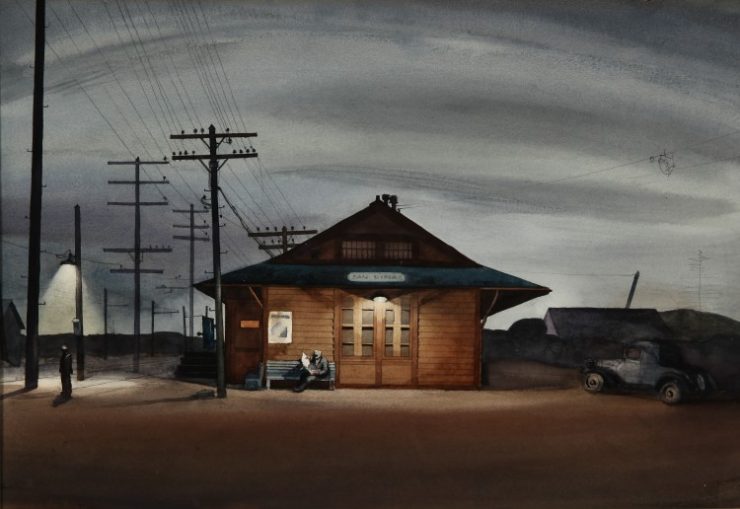




This is great news! A fantastic collection! Many thanks to Mark & Janet Hilbert for their focus and passion in assembling these wonderful pieces. And for their generous donation to Chapman University for the museum!